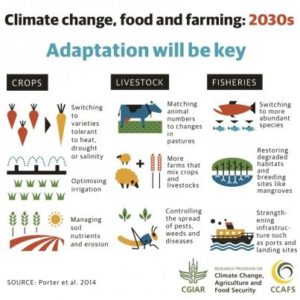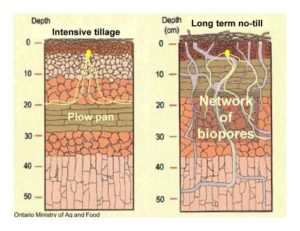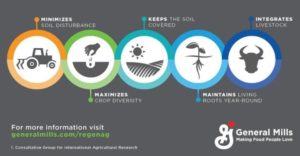Practicing Regenerative Agriculture to Reverse Climate Change
Agriculture is one of the leading contributors to climate change. Agricultural practices, livestock, and wasted food sitting in landfills all release greenhouse gases into the air that trap the sun’s radiation. But did you know that, conversely, climate change impacts agriculture? Rapidly changing climates are impacting agricultural practices, rising carbon dioxide emissions are lowering zinc and iron levels in crops, rising sea levels are increasing saltwater invasion into freshwater aquifers, and both flooding and draughts are threatening to destroy crops.
If the agricultural industry does not adapt to the new environmental conditions caused by climate change, by 2050—and even as early as 2030—we could see serious food shortages. In order to reverse the effects of climate change caused, in part, by the agricultural industry, farmers are now practicing regenerative agriculture.

Figure 1: Regenerative agricultural practices that will help us adapt to environmental conditions caused by climate change
You might be wondering: can regenerative agriculture actually help the environment? Can any agricultural practice really be good for the environment?
Well, yes.
Regenerative agriculture refers to farming practices that reverse climate change, support soil fertility and health, limit water waste and pollution, and increase biodiversity. By rebuilding soil organic matter, farmers practicing regenerative agriculture can lower carbon emissions and improve the water cycle. These farmers participate in one or more of the following four practices:
- Minimum or no Tillage
- Building Biological Ecosystem Diversity
- Well-managed Grazing Practices
- Increasing Soil Fertility
Tillage
Tillage, the process by which soil is prepared for the sowing of seeds, uses machines that pulverize the soil and, in turn, destroy soil aggregation and fungal communities, add excess oxygen to the soil, increase soil erosion and carbon loss, and cause an increase in water runoff and soil loss.

Figure 2: Intensive tillage reduces soil biodiversity and fertility by compacting the soil. No-tillage practices support biopore networks, allowing microorganisms, such as worms and ants, to move through the soil. Picture courtesy of Ontario Ministry of Agriculture and Food.
Following regenerative, no-tillage practices, farmers can enhance soil aggregation, water infiltration and retention, and carbon sequestration. Some soils, however, need intermittent ripping to break apart hardpans, or dense layers of soil, so minimum-tillage practices may benefit these soils more than no-tillage practices.
Building Biological Ecosystem Diversity
To support and increase diversity within the ecosystem, farmers should begin by restoring the soil’s microbial community population and structure, which can be accomplished by using compost to add nutrients to the soil. Farmers can also restore soil system energy by implementing fulltime, multiple crop and intercrop plantings. Pollinators, such as bees and other insects, who help pollinate our crops should also be protected and supported by providing safe habitats.
Well-managed Grazing Practices
By adding livestock to their agricultural practices, farmers can:
- Improve ecological health
- Stimulate plant growth
- Increase soil carbon deposits
- Increase soil fertility
- Support and increase insect and plant biodiversity and
- Increase soil carbon sequestration.
It is important, however, to implement healthy grazing practices. Feedlots and confined animal feeding systems contribute negatively to the environment by supporting unhealthy monoculture production systems and low nutrient density fodder, increasing water pollution, contributing to antibiotic usage and resistance, and increasing carbon dioxide and methane emissions.
For healthy grazing practices, follow these rules:
- Let animals graze for five to seven days
- Provide a two-three week recovery period for the field
- For late summer and early fall, provide a six-eight week recovery period
Increasing Soil Fertility
Restoring the plant and soil microbiome promotes the cycle of essential nutrients throughout soil. To increase soil fertility, farmers might implement cover crops, crop rotations, compost, and animal manure. This year, General Mills announced its plan to convert its farmland to regenerative agriculture by 2030, implementing minimum-tillage practices, crop covers, and livestock for manure, among other practices.

Figure 3: General Mills’ plan to implement regenerative agriculture practices. Picture courtesy of General Mills.
Soil infertility, however, isn’t simply caused by over-tillage and a lack of nutrients. Artificial and synthetic fertilizers have wreaked havoc on the structure and function of soil’s microbial communities, “bypassing the natural biological acquisition of nutrients for the plants, creating a dependent agroecosystem and weaker, less resilient plants” (California State University, Chico).
According to studies, artificial and synthetic fertilizers contribute to climate change in four ways: energy costs for the production and transportation of fertilizer, chemical breakdown into water resources via runoff and the atmosphere via evaporation, the destruction of microbial communities, and the accelerated decomposition of soil organic matter.
At xVirity, our mission is to support the natural resources of the planet and enhance food production worldwide. As previously mentioned, conventional fertilizers contribute to climate change, as excess nitrogen in the soil is consumed by microbes and released into the air as nitrous oxide, a global warming gas. Additionally, salts in conventional fertilizers hurt the environment and reduce crop yield by reducing germination, killing vegetation, preventing water absorption, and weakening plant growth. Our liquid fertilizer, however, is salt free, thus eliminating the problems caused by conventional fertilizers. xVital helps support the environment and your crops by:
- Eliminating runoff
- Eliminating salt
- Reducing rot, fungus, and algae
- Enhancing plant health and
- Supporting pH balance.
Saving the environment isn’t something in which only tree-hugging hippies see value. If we want to live to 2050 and to yield healthy, abundant crops, we must act now. Practicing regenerative agriculture is a huge step in helping to reverse the climatic effects caused, in part, by the agricultural industry. To improve your crop yield and help support a healthy environment, check out xVital today.
Sources:
Why Natural Fertilizers can Help Improve Soil Health

